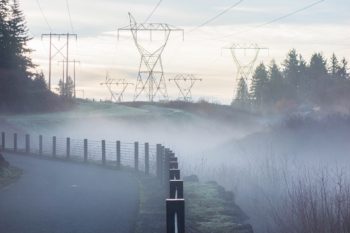
It’s not an “endowed by our Creator” human right, nor one enunciated by a constitution or UN charter. It’s not akin to freedom of religion or speech. It’s not some entitlement we get for free.
But it is definitely a fundamental right of access to this all-empowering energy source; a right for all human lives to be improved and blessed the way ours have been; a right to never be denied access to sufficient, reliable, affordable electricity, on a phony claim that letting you have it would hurt the environment or climate.
Try to imagine your home, school, healthcare, business, community, or world – your life – without this amazing energy source, and you will wholeheartedly agree with Bryce.
In chapter 16, Bryce speaks of “the Terawatt Challenge.” It’s a term coined by the late Nobel Laureate Richard Smalley, who posited that, if we can provide sufficient electricity to all peoples of the world, we can largely eliminate the massive problems of poverty, polluted environments, unsafe water, and food insecurity.
Bryce solemnly notes that our world is still far from that goal. But we can get there.
Bryce traces the history of harnessed electricity, from Benjamin Franklin through Tesla, Edison and Westinghouse – to the much less well known but equally important Frank Julian Sprague, who developed electric elevator motors (enabling skyscrapers) and the nation’s first electric rail system.
He illustrates how Franklin Roosevelt brought affordable electricity to rural America and oversaw the construction of massive dams that provided cheap electricity to every corner of America.
It was FDR, Bryce notes, who in 1932 proclaimed that “Electricity is no longer a luxury; it is a definite necessity.”
Bryce then hits us with the horrific reality that roughly 3.3 billion people (45% of humanity!) still live today in places where annual per capita electricity consumption is less than 1,000 kilowatt-hours per year (kWh/yr) – about what his home refrigerator uses. These people barely survive in unplugged countries.
Another 2.7 billion people (37%) scrape by in low-watt countries. Only 19% of all people on planet Earth live in “high-watt” nations (more than 4,000 kWh/yr) – the bottom threshold, says Dr. Alan Pasternak, the key dividing line below which countries cannot improve their Human Development Index.
A major barrier, therefore, to electricity sufficiency for the unplugged – and even the low-watt – nations is the lack of societal integrity, capital investment, and affordable energy.
Yet, to ensure that all humanity can reach its full potential – to liberate women from endless drudgery, enabling them to develop their innate skills and talents – requires that the human right to electricity be recognized and made a reality.
How do we reach this lofty but essential goal? An essential component of societal integrity is that governments enforce the rule of law. The freest and wealthiest countries are those where factions share political and economic power.
In the poorest countries, elites organize society for their own benefit at the expense of the vast mass of people. Capital – and energy – are much easier to obtain in a free society.
To illustrate the magnitude of the gap between Unplugged and High-Watt nations, Bryce chronicles the meteoric rise of the Giant Five – Alphabet (Google), Amazon, Apple, Facebook, and Microsoft – each of which consumes more electricity each year than many entire countries.
Financial services, from Visa to Bitcoin, also have giant electricity appetites, as does the marijuana industry.
These businesses all know from experience the cost that electricity blackouts impose on them – and their customers.
Both weather and sabotage threaten the integrity of the electric grid, but the greater threat is the folly of those who believe that wind and solar alone can provide sufficient electric energy for a high-tech society, let alone the world’s billions.
Bryce chronicles how four factors – cost, storage, scale, and land use – prevent renewables from taking over our energy and power systems.
Electricity prices are soaring in countries like Germany, which panicked after Fukushima and began shuttering its nuclear power plants.
A third of German businesses, including automotive, see high electricity costs as threats to their viability, Bryce notes.
Rising electricity costs following the enactment of Ontario’s Green Energy Act led to political defeat for the Liberal Party and the rescission of 758 renewable energy contracts.
Even in California, civil rights leaders have filed a lawsuit, decrying how the state’s climate policies discriminate against minority and low-income consumers; it is now working its way through the legal system.
Bryce’s reporting suggests that the elitists who are pushing renewable energy – like despots in broken (low-watt or unplugged) countries – ignore the poor and middle class and treat rural areas as if they were uninhabited or just irrelevant, as they pursue unattainable goals that heavily burden taxpayers while threatening electricity reliability.
Meeting California’s 80% renewable mandate, for example, will require massive increases in costly electric storage because of seasonal variation in wind and solar electricity generation.
Green energy growth today cannot even keep up with the annual increase in global electricity demand, let alone replace all conventional power. But the final nail in the renewables coffin is land use.
Bryce cites multiple studies showing that an all-wind grid would mean turbine farms would cover a tenth of the nation’s total land. Frustrated by the indifference of urban elites to the real-world impacts on human health and wildlife, rural counties are fighting wind farms with renewed vengeance.
Giant solar arrays also present a choice between vanishing ecosystems and “clean” energy that is actually highly polluting. Mining for metals and minerals to build wind and solar systems would also be monumental.
Despite opposition by environmentalists, developing nations are rapidly turning to nuclear as fuel for the future.
But, Bryce notes, it takes national commitments akin to the New Deal to provide both the political stability and financial backing to construct and operate large nuclear power plants economically.
High-watt countries have imposed exorbitant permitting and regulatory costs on themselves and poor countries; together with antinuclear zeal, this greatly limits the prospects for nuclear energy.
Thanks to fracking, natural gas has become abundant and cheap. It must be a major part of the world’s electricity generation future.
Yet governments in high-watt countries are already banning fracking, blocking new pipelines, and even demanding that citizens mothball their gas-burning appliances.
Despite all the attacks on affordable, reliable fuels, Bryce is optimistic about the world’s ability and willingness to meet the terawatt challenge and provide electricity to a hungry world, without wrecking the biosphere.
Indeed, in little over a century, a fifth of the world has gone from no electricity to high-watt usage and another three-eighths is somewhat electrified – and their environments are better for it.
The humanist response to the Terawatt Challenge, Bryce asserts, is to empower the billions who are living in the dark to come into the bright light of modernity, progress, and better, longer, healthier lives.
This will require societal integrity, massive infusions of capital, and the right choices of fuels. Bryce admits that electrifying the world will take time. But it can – and must – be done.
Government regulation of these entities has become increasingly bloated and corrupt, Bryce notes.
We must significantly change our standards for both fossil fuel and nuclear power plants, to acknowledge technological improvements, the falsity of many environmentalist claims, and the fact that not having more of those power plants impose enormous costs on lands, wildlife, human health, and human rights.
Duggan Flanakin is director of policy research for the Committee For A Constructive Tomorrow (www.CFACT.org) and author of many articles on energy, climate change, and environmentalism.

















Meeting The Terawatt Challenge… Good luck with that.
Robert Bryce names elites, environmentalists and Government but what he doesn’t address is who “they” have become. THEY are now progressivism. Progressive elites, progressive environmentalists, progressive institutions, progressive governments and progressive globalists.
“Despite all the attacks on affordable, reliable fuels, Bryce is optimistic about the world’s ability and willingness to meet the terawatt challenge and provide electricity to a hungry world, without wrecking the biosphere.”
Bryce is way too late and unrealistic in his optimism. Progressives are now a well established, extremely well funded and well organized global political force. And progressive policies do not seek to “empower the billions who are living in the dark to come into the bright light of modernity, progress, and better, longer, healthier lives.” Unfortunately it will now take more than a “willingness” to defeat progressivism.
See “Why Progressive Institutions are Unsustainable” by Richard A. Epstein
They need to have electicity in their homes and better homes in Africa and yes plenty of Food that means Fertilizers and Pesticides and no more excuses